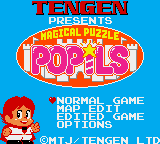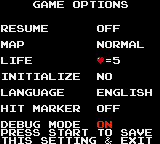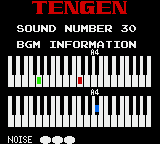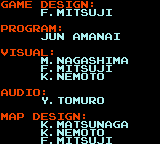Magical Puzzle Popils
| Magical Puzzle Popils |
|---|
|
Also known as: Popils: The Blockbusting Challenge (EU)
|
An adorable and addictive puzzle game by the designer of Bubble Bobble. Both Famicom and PC Engine versions were in the works, but unfortunately ended up being scrapped.
Contents
Sub-Page
| Prerelease Info |
Programmer's Credit
This text is located at offset 0x6F in the game data:
Copyright 1991 TENGEN LTD. Programmed by Jun Amanai.
Debug Mode
This text is located at offset 0xAEF6 in the game data, near the items on the options screen:
DEBUG MODE
The hidden Debug Mode menu item on the Options screen can be activated by putting 0xFF into memory location 0xD3F3.
Debug Mode has the following effects:
- Displays mapper/you step counts before every round (usually the step counts are displayed only after you've beaten a round).
- Allows you to access rounds 1-100 from the beginning (usually the rounds are gradually unlocked through play).
Secret Extra Round
The Japanese Manual for the game seeds the rumour that there are in fact 101 rounds not 100. Whilst not cut from the game this reference was cut from the USA and European manuals.
Secret Round 0 is only accessible if you finish each round "perfectly" which means equalling or beating the "mapper" step count for every round. The hint for this round is a message from the programmer. The round is marked as Secret on the round selection screen.
Unused Sprites
The player sprite can kick, punch and head-butt to break blocks below, beside and above them. There are messages in the tile data for HEAD-BUTT and KICK, but they are unused in the game.
Also in the tile data are two small versions of the player sprite with fists (one facing left, the other facing right), and an extra smiley face. These are all at the size used for display within text or on the "mini map" round selection screen.
Sound Test Mode
On the Options menu, press 1+START to get to the sound test.
| To do: Check if all sounds/music are used in the game. |
Alternative Credits
There is an alternative set of credits located at offset 0xB069 in the game data. This credits screen is shown on the second page of the Japanese manual with the caption "Credit screen occasionally appearing". The alternative credits sometimes appear before the main menu appears.
The code that governs the appearance of these credits asks for the following conditions to be satisfied:
- Region of Game Gear hardware is Japan.
- We are about to see the Main Menu.
- The number of times the Main Menu has been viewed is a multiple of 8.
The credits will not trigger if any of these conditions are false. For example, if you are using an "Export" (non-Japanese) Game Gear the alternative credits will not appear.
The fastest way to see them is to go in and out of the options screen 7 times. Alternatively, put your emulator in fast forward and watch the attract mode for 8 cycles.
Hints
Hints are different in Japanese and English. Most notably is that English uses graphical tiles in place of words - similar to emoji - to help with the limited line length available to spell things out.
| To do: Compare translated Japanese hints with English hints. |
- Pages missing developer references
- Games developed by MTJ
- Games developed by Jun Amanai
- Games developed by Tengen
- Pages missing publisher references
- Games published by Tengen
- Game Gear games
- Pages missing date references
- Games released in 1991
- Games released in July
- Games released on July 12
- Games with hidden developer credits
- Games with hidden development-related text
- Games with unused graphics
- Games with unused text
- Games with debugging functions
- Games with hidden sound tests
- Games with hidden level selects
- Games with regional differences
- Games with hidden bonus content
- To do
Cleanup > Pages missing date references
Cleanup > Pages missing developer references
Cleanup > Pages missing publisher references
Cleanup > To do
Games > Games by content > Games with debugging functions
Games > Games by content > Games with hidden bonus content
Games > Games by content > Games with hidden developer credits
Games > Games by content > Games with hidden development-related text
Games > Games by content > Games with hidden level selects
Games > Games by content > Games with hidden sound tests
Games > Games by content > Games with regional differences
Games > Games by content > Games with unused graphics
Games > Games by content > Games with unused text
Games > Games by developer
Games > Games by developer > Games developed by Jun Amanai
Games > Games by developer > Games developed by MTJ
Games > Games by developer > Games developed by NetherRealm Studios > Games developed by Midway Games > Games developed by Atari Games
Games > Games by developer > Games developed by Time Warner Interactive > Games developed by Tengen
Games > Games by platform > Game Gear games
Games > Games by publisher
Games > Games by publisher > Games published by Warner Bros. Games > Games published by Midway Games > Games published by Atari Games > Games published by Tengen
Games > Games by release date > Games released in 1991
Games > Games by release date > Games released in July
Games > Games by release date > Games released in July > Games released on July 12




